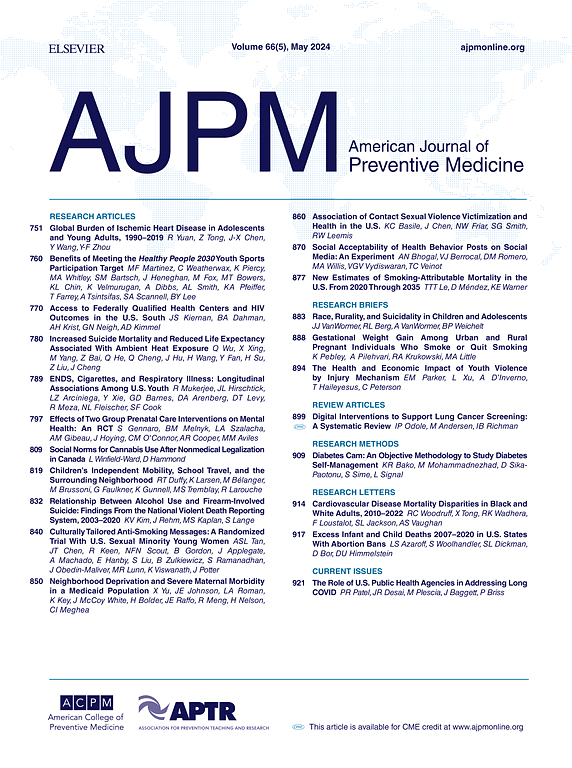Federal Firearm Licensee Rates and Suicide in Maryland, 2014 to 2019
IF 4.5
2区 医学
Q1 MEDICINE, GENERAL & INTERNAL
引用次数: 0
Abstract
Introduction
Federal firearm licensee density is associated with interpersonal firearm violence. Yet the role of Federal firearm licensees in firearm suicide remains understudied, even though firearms are the method used in more than half of suicides. This study tested associations between the spatial distribution of federal firearm licensees and firearm suicides in Maryland.
Methods
Kernel density estimation measured federal firearm licensee and suicide rates at the census tract level (n=1,397), and SaTScan detected clusters of licensees and suicides. Choropleth maps compared visual associations between federal firearm licensee, firearm, and non-firearm suicide rates and clusters. Generalized estimating equations tested associations between Federal firearm licensee rates and clusters and the odds of using a firearm as the lethal means overall and after stratifying by biological sex. Data were obtained in 2020 and analyzed in 2020–2024.
Results
The federal firearm licensee rate was associated with greater odds of firearm suicide overall (aOR=1.29, 95% CI=1.21, 1.38, p<0.001), for men (aOR=1.29, 95% CI=1.20, 1.39, p<0.001), and for women (aOR=1.26, 95% CI=1.07, 1.49, p=0.007). Suicide decedents in a census tract located in a federal firearm licensee cluster (vs not) had higher odds of firearm use overall (aOR=1.70, 95% CI=1.28, 2.27, p<0.001) and for men (aOR=1.67, 95% CI=1.22, 2.27, p=0.001), but not for women (aOR=1.65, 95% CI=0.81, 3.34, p=0.168).
Conclusions
The federal firearm licensee rate and clusters were associated with firearm suicides and unrelated to the spatial distribution of non-firearm suicides. Prevention approaches that limit the number of these federal firearm licensees or alter their sales practices, such as federal firearm licensee zoning and land use provisions, advertising restrictions, or gun shop projects, may prevent firearm suicides.
2014 年至 2019 年马里兰州的联邦枪支持证率和自杀率。
导言:联邦枪支持证人的密度与人际间的枪支暴力有关。然而,尽管半数以上的自杀案件中使用的是枪支,但联邦枪支执照持有者在枪支自杀中所扮演的角色仍未得到充分研究。本研究测试了马里兰州联邦持枪许可证持有者的空间分布与持枪自杀之间的关联:方法:核密度估计测量了人口普查区一级(n=1,397)的联邦持枪许可证持有者和自杀率,SaTScan检测了持枪许可证持有者和自杀者的集群。Choropleth 地图比较了联邦枪支持证者、枪支和非枪支自杀率与集群之间的直观关联。广义估计方程检验了联邦持枪执照者自杀率和集群与使用枪支作为致命手段的几率之间的整体关联,以及按生理性别分层后的关联。数据于 2020 年获得,分析时间为 2020-2024 年:结果:联邦持枪者持枪率与总体持枪自杀几率增大相关(aOR=1.29,95% CI=1.21,1.38,p结论:联邦持枪者持枪率和集群与总体持枪自杀几率增大相关:联邦枪支持证人比率和集群与枪支自杀有关,与非枪支自杀的空间分布无关。限制这些联邦枪支执照持有者的数量或改变其销售行为的预防方法,如联邦枪支执照持有者分区和土地使用规定、广告限制或枪支商店项目,可能会预防枪支自杀。
本文章由计算机程序翻译,如有差异,请以英文原文为准。
求助全文
约1分钟内获得全文
求助全文
来源期刊

American Journal of Preventive Medicine
医学-公共卫生、环境卫生与职业卫生
CiteScore
8.60
自引率
1.80%
发文量
395
审稿时长
32 days
期刊介绍:
The American Journal of Preventive Medicine is the official journal of the American College of Preventive Medicine and the Association for Prevention Teaching and Research. It publishes articles in the areas of prevention research, teaching, practice and policy. Original research is published on interventions aimed at the prevention of chronic and acute disease and the promotion of individual and community health.
Of particular emphasis are papers that address the primary and secondary prevention of important clinical, behavioral and public health issues such as injury and violence, infectious disease, women''s health, smoking, sedentary behaviors and physical activity, nutrition, diabetes, obesity, and substance use disorders. Papers also address educational initiatives aimed at improving the ability of health professionals to provide effective clinical prevention and public health services. Papers on health services research pertinent to prevention and public health are also published. The journal also publishes official policy statements from the two co-sponsoring organizations, review articles, media reviews, and editorials. Finally, the journal periodically publishes supplements and special theme issues devoted to areas of current interest to the prevention community.
 求助内容:
求助内容: 应助结果提醒方式:
应助结果提醒方式:


